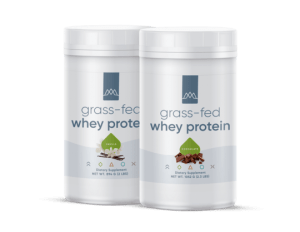Osteoporosis can make your bones become more fragile. Your body isn’t replacing old bone with new bone, so you have an increased risk of fractures with this condition. Even something simple like bending over can damage your bones.1
Men and women are both at risk for osteoporosis. In America, over 53 million people either have this condition or have a high risk for developing it.2
Strong bones provide the body with structural support, help maintain strength and mobility, and protect the brain and internal organs. Bones also store essential nutrients that the body can use to help other organs function.
Nutrient-wise, calcium probably comes to mind when you think about maintaining strong bones. Indeed, about 99 percent of this mineral resides in your bones. Low levels of calcium can contribute to low bone mass, rapid bone loss, and high fracture rates.
Calcium works with other vitamins and minerals to support strong bones. Vitamin D, for instance, helps the gut absorb calcium and supports bone maintenance. Deficiencies in this vitamin can impair muscular function, increasing the risk of falls and injuries among older people.3
Magnesium is another mineral crucial for bone health. Studies show that around 75 percent of Americans are deficient in magnesium.4 Magnesium deficiencies can contribute to osteoarthritis.5 Low levels of this mineral can also impair vitamin D and calcium.6
Other key nutrients for bone health include vitamin C, which supports bone density. Vitamin C also helps synthesize collagen, the primary structural protein in bones.7
The skeleton demands adequate amounts of these and other vitamins and minerals. At the same time, bones provide a reservoir for the rest of the body. When the body removes too many nutrients from the skeletal system, your bones can become weak.
Bone loss does occur as we get older. That doesn’t mean you have to settle for fractures and other problems that may occur with age. With these three strategies, you can keep your bones strong and healthy and reduce your risk of osteoporosis.8
Eat Bone-Supporting Foods
Whole, unprocessed foods provide a wide array of vitamins, minerals, and other nutrients that strong bones need. Among those foods include:
- About 50 percent of bone is made of protein. The right amount of protein supports calcium absorption. Protein also impacts bone formation and breakdown.9Good protein sources include grass-fed beef, pasture-raised eggs, and organic free-range poultry. Blending our Grass-Fed Whey Protein into our Very Berry Smoothie makes a delicious protein source to start your day.
- Chronic inflammation can contribute to osteoporosis. The anti-inflammatory omega-3 fatty acids in wild-caught seafood support bone health and prevent osteoporosis. Wild-caught fish also provides protein and bone-supporting nutrients including vitamin D.10

- Leafy and cruciferous vegetables provide key nutrients including vitamin C and calcium for strong bones.11 Our Spinach Bake makes a delicious way to get more of these vegetables!
- Nuts and seeds are nutrient powerhouses. They provide calcium, magnesium, and other vitamins and minerals that strong bones demand.12
Our Core and Advanced Plans incorporate these and other delicious, satisfying foods to support bone health and prevent osteoporosis.
Exercise Regularly
Consistently working out keeps your bones strong. Even if you have osteoporosis, regular exercise can help maintain bone mass.13 To support strong bones, consider these types of exercise:
- Strength training exercises
- Weight-bearing aerobic activities
- Flexibility exercises
- Stability and balance exercises14
What matters is what works for you. Talk with your healthcare practitioner about specific exercises to support bone health, especially if osteoporosis prevents you from working out.
For a 12-minute exercise program that gives you maximum return for minimum time, try MaxT3, MaxLiving’s HIIT (High-Intensity Interval Training) workout program.
References
- https://www.mayoclinic.org/diseases-conditions/osteoporosis/symptoms-causes/syc-20351968
- https://www.bones.nih.gov/health-info/bone/osteoporosis/overview#Prevention
- https://www.ncbi.nlm.nih.gov/pubmed/9988294
- https://www.ncbi.nlm.nih.gov/pmc/articles/PMC5786912/
- https://www.ncbi.nlm.nih.gov/pmc/articles/PMC3775240/
- https://www.medicalnewstoday.com/articles/316922
- https://americanbonehealth.org/nutrition/vitamins-for-bone-health/
- https://www.webmd.com/healthy-aging/features/bone-strength#1
- https://www.healthline.com/nutrition/build-healthy-bones#section2
- https://www.ncbi.nlm.nih.gov/pmc/articles/PMC3899785/
- https://www.nof.org/patients/treatment/nutrition/
- https://americanbonehealth.org/nutrition/nutrientsforbonehealth/
- https://www.webmd.com/osteoporosis/features/exercise-for-osteoporosis#1
- https://www.mayoclinic.org/diseases-conditions/osteoporosis/in-depth/osteoporosis/art-20044989
- https://americanbonehealth.org/nutrition/nutrientsforbonehealth/
- https://www.medicalnewstoday.com/articles/295599




